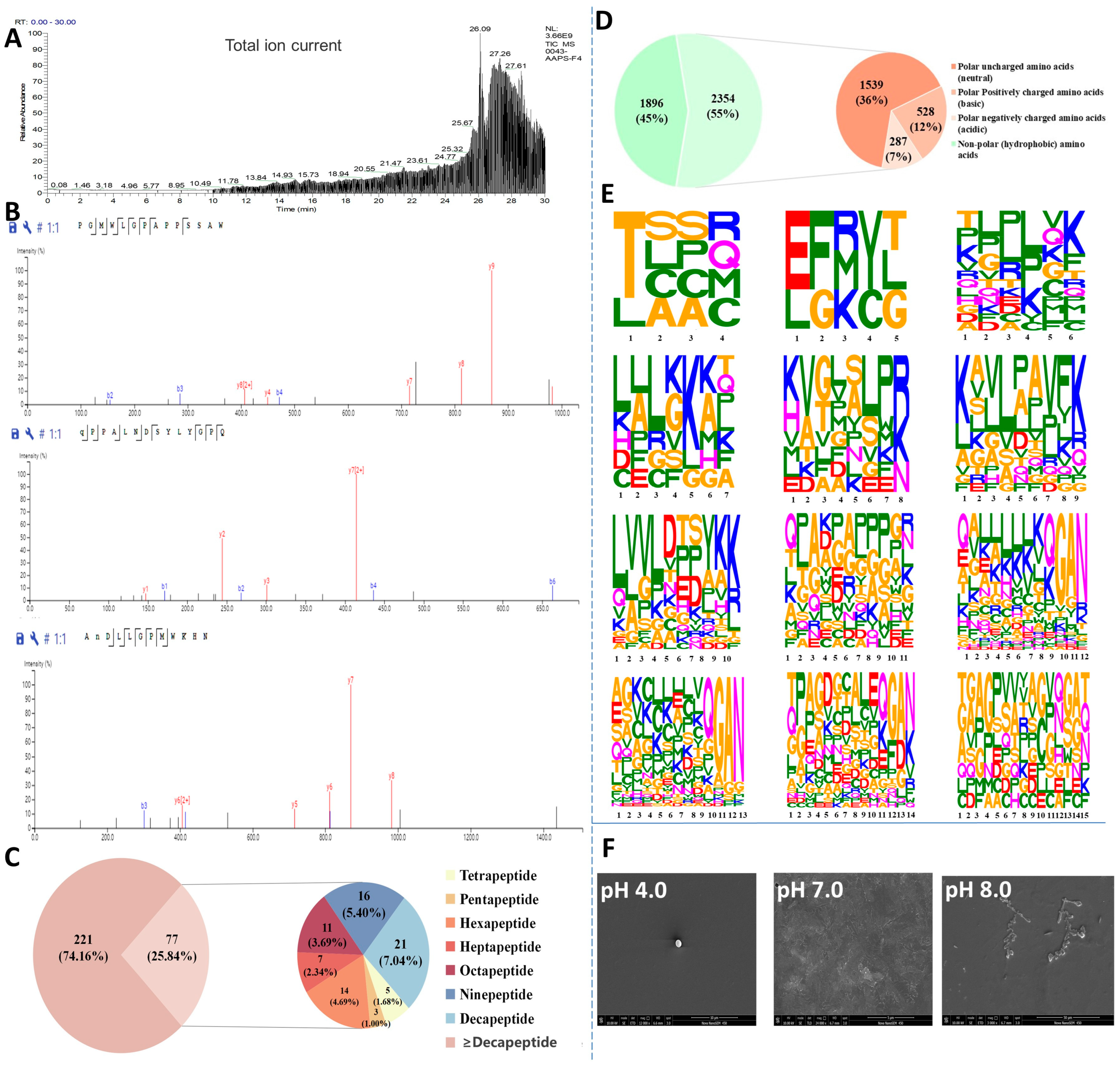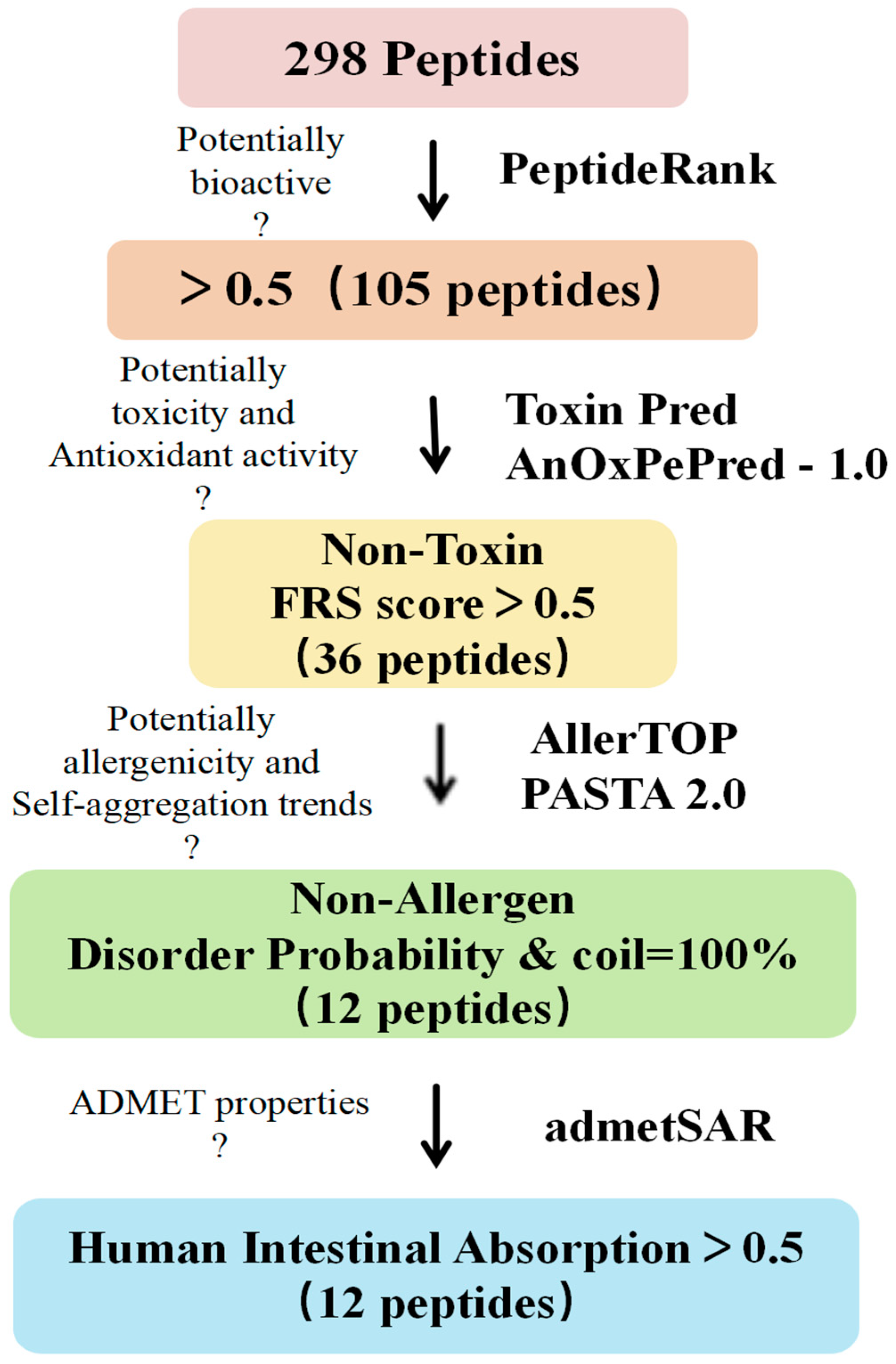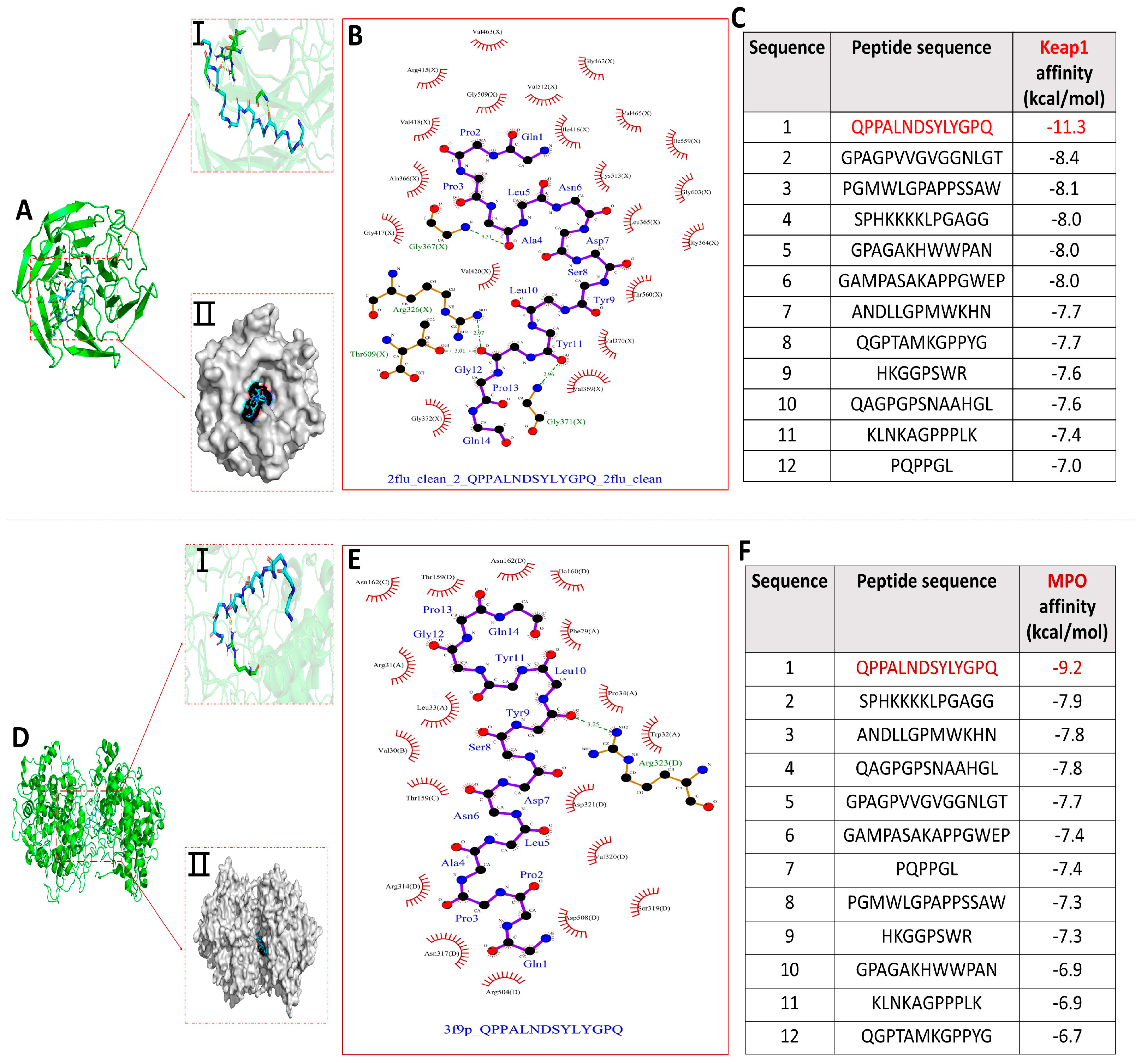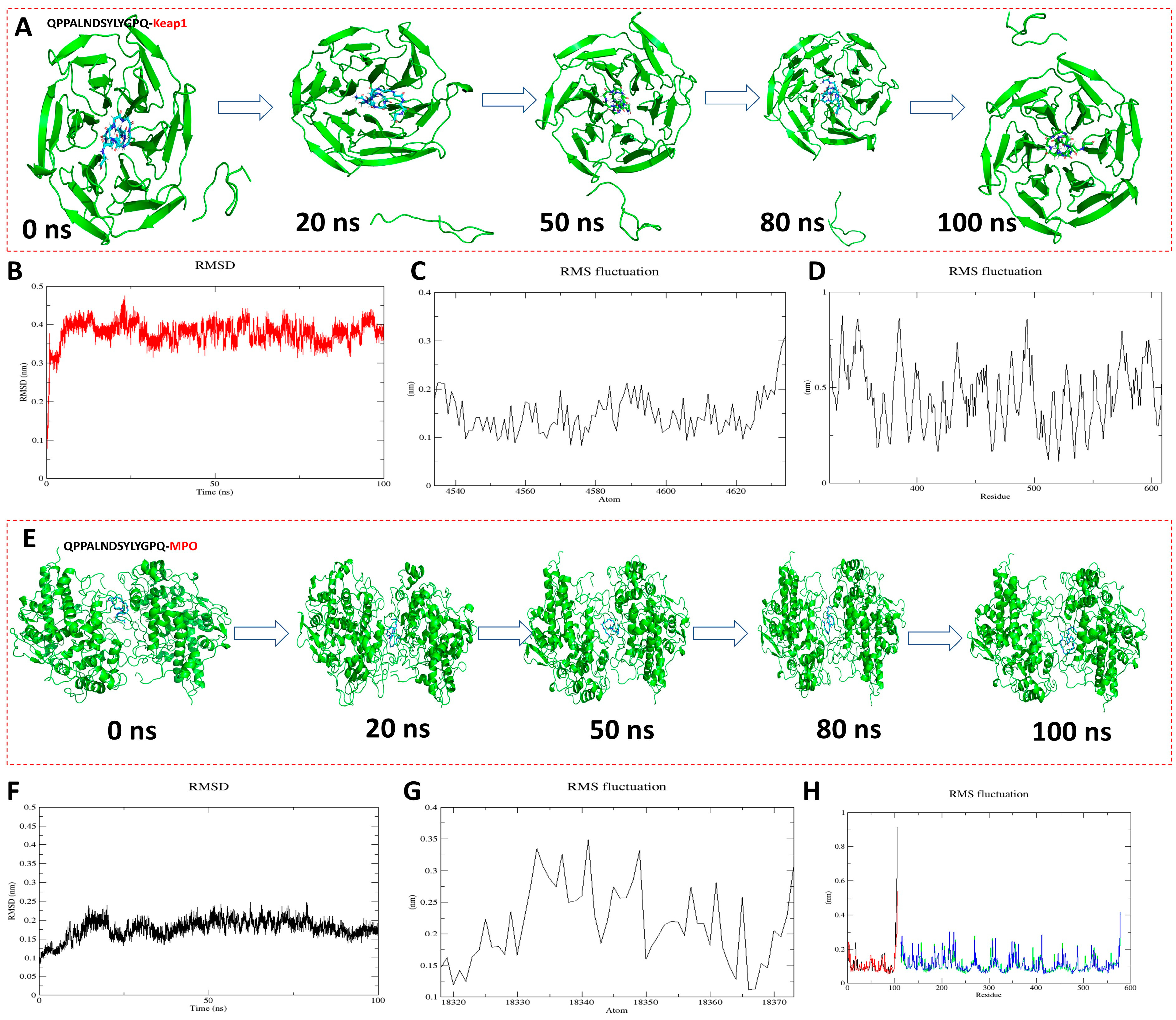Novel Antioxidant Self-Assembled Peptides Extracted from Azumapecten farreri Meat: In Vitro- and In Silico-Assisted Identification
Abstract
1. Introduction
2. Materials and Methods
2.1. Materials
2.2. Preparation and Purification of AAPs
2.3. In Vitro Antioxidant Activity Assay
2.4. LC-MS/MS Analysis
2.5. Characterization of pH-Responsive Self-Assembly Morphology
2.6. In Silico-Assisted Screening of Novel Antioxidant Peptides and Physicochemical Analysis
2.7. Molecular Docking
2.8. Molecular Dynamics Simulation
2.9. Data Statistics and Analysis
3. Results and Discussion
3.1. Purification and Antioxidant Activity of Azumapecten farreri Meat Peptides
3.2. Identification, Resolution, and Characterization of Antioxidant Self-Assembling Peptides in Azumapeten farreri Meat
3.3. In Silico Screening and Physicochemical Property Evaluation of Peptide Segments
3.4. Molecular Docking Screening of Antioxidant Peptides in Azumapecten farreri Meat
3.5. Molecular Dynamics Modeling of Antioxidant Mechanisms
4. Conclusions
Supplementary Materials
Author Contributions
Funding
Institutional Review Board Statement
Informed Consent Statement
Data Availability Statement
Acknowledgments
Conflicts of Interest
References
- Girgih, A.T.; He, R.; Malomo, S.; Offengenden, M.; Wu, J.P.; Aluko, R.E. Structural and functional characterization of hemp seed (L.) protein-derived antioxidant and antihypertensive peptides. J. Funct. Foods 2014, 6, 384–394. [Google Scholar] [CrossRef]
- Du, Z.J.; Comer, J.; Li, Y.H. Bioinformatics approaches to discovering food-derived bioactive peptides: Reviews and perspectives. TrAC Trend Anal. Chem. 2023, 162, 117051. [Google Scholar] [CrossRef]
- Yan, S.; Yue, Y.Z.; Zeng, L.; Su, L.L.; Hao, M.; Zhang, W.; Wang, X.P. Preparation of Graphene Oxide-Embedded Hydrogel as a Novel Sensor Platform for Antioxidant Activity Evaluation of. Front. Chem. 2021, 9, ARTN675346. [Google Scholar] [CrossRef]
- Yan, S.; Liu, X.H.; Sang, Y.X.; Tian, G.F. Gel mechanism analysis of minced scallop meat modified by three kinds of food colloids. Food Biosci. 2024, 57, 103541. [Google Scholar] [CrossRef]
- Wang, X.F.; Yang, Z.J.; Jiang, L.M.; Liu, Z.; Dong, X.X.; Sui, M.Y.; Yin, C.L.; Shen, X.J.; Zhao, A.; Hu, J.J.; et al. Assessment of germplasm resource and detection of genomic signature under artificial selection of Zhikong scallop. Aquaculture 2023, 574, 739730. [Google Scholar] [CrossRef]
- Han, J.R.; Yan, J.N.; Sun, S.G.; Tang, Y.; Shang, W.H.; Li, A.T.; Guo, X.K.; Du, Y.N.; Wu, H.T.; Zhu, B.W.; et al. Characteristic antioxidant activity and comprehensive flavor compound profile of scallop mantle hydrolysates-ribose Maillard reaction products. Food Chem. 2018, 261, 337–347. [Google Scholar] [CrossRef]
- Yang, F.M.; Wang, Z.C.; Zhao, D.; Hu, L.; Cui, S.H.; Chen, L.Q.; Guo, T.T.; Pan, P.P.; Chen, J.D. Food-derived peptides self-assembled supramolecules for scarless healing. Compos. Part. B Eng. 2022, 246, 110265. [Google Scholar] [CrossRef]
- Vijaykrishnaraj, M.; Prabhasankar, P. Marine protein hydrolysates: Their present and future perspectives in food chemistry—A review. RSC Adv. 2015, 5, 34864–34877. [Google Scholar] [CrossRef]
- Lorenzo, J.M.; Munekata, P.E.S.; Gómez, B.; Barba, F.J.; Mora, L.; Pérez-Santaescolástica, C.; Toldrá, F. Bioactive peptides as natural antioxidants in food products—A review. Trends Food Sci. Tech. 2018, 79, 136–147. [Google Scholar] [CrossRef]
- Xu, B.T.; Dong, Q.; Yu, C.X.; Chen, H.Y.; Zhao, Y.; Zhang, B.S.; Yu, P.L.; Chen, M.J. Advances in Research on the Activity Evaluation, Mechanism and Structure-Activity Relationships of Natural Antioxidant Peptides. Antioxidants 2024, 13, 479. [Google Scholar] [CrossRef]
- Zhu, Y.S.; Lao, F.; Pan, X.; Wu, J.H. Food Protein-Derived Antioxidant Peptides: Molecular Mechanism, Stability and Bioavailability. Biomolecules 2022, 12, 1622. [Google Scholar] [CrossRef]
- Olsen, T.H.; Yesiltas, B.; Marin, F.I.; Pertseva, M.; García-Moreno, P.J.; Gregersen, S.; Overgaard, M.T.; Jacobsen, C.; Lund, O.; Hansen, E.B.; et al. AnOxPePred: Using deep learning for the prediction of antioxidative properties of peptides. Sci. Rep. 2020, 10, 21471. [Google Scholar] [CrossRef]
- López-García, G.; Dublan-García, O.; Arizmendi-Cotero, D.; Oliván, L.M.G. Antioxidant and Antimicrobial Peptides Derived from Food Proteins. Molecules 2022, 27, 1343. [Google Scholar] [CrossRef]
- Zhang, G.L.; Liang, Y.; Zhu, J.Y.; Jia, Q.; Gan, W.Q.; Sun, L.M.; Hou, H.M. Oxidative stress-mediated antiproliferative effects of furan-containing sulfur flavors in human leukemia Jurkat cells. Food Chem. 2015, 180, 1–8. [Google Scholar] [CrossRef]
- Qin, Y.; Xu, Y.Y.; Yi, H.X.; Shi, L.R.; Wang, X.; Wang, W.S.; Li, F.C. Unique structural characteristics and biological activities of heparan sulfate isolated from the mantle of the scallop. Carbohyd Polym. 2024, 324, 121431. [Google Scholar] [CrossRef]
- Wu, D.; Wu, C.; Ma, W.C.; Wang, Z.Y.; Yang, M.L.; El-Seedi, H.R.; Du, M. Coiled-coil scallops peptide hydrogel with metal ionic and temperature tunable assembly. Food Chem. 2024, 433, 137230. [Google Scholar] [CrossRef]
- Yang, F.M.; Zhao, D.; Zhang, K.; Wang, Z.C.; Wang, Y.X.; Wu, C.C.; Cui, S.H.; Guo, T.T.; Chen, L.Q.; Chen, J.D. Oral delivery of marine shellfish supramolecule peptides for skin wound healing. Colloid. Surface B 2022, 216, 112592. [Google Scholar] [CrossRef]
- Zhang, T.; Yang, F.M.; Qin, X.M.; Yang, X.M.; Zhang, C.H.; Wan, Z.Y.; Lin, H.S. Investigation of the In Vivo, In Vitro, and In Silico Wound Healing Potential of Purified Peptides. Mar. Drugs 2022, 20, 417. [Google Scholar] [CrossRef]
- Zhu, L.J.; Xiong, H.G.; Huang, X.; Guyonnet, V.; Ma, M.H.; Chen, X.Q.; Zheng, Y.T.; Wang, L.M.; Hu, G. Identification and molecular mechanisms of novel antioxidant peptides from two sources of eggshell membrane hydrolysates showing cytoprotection against oxidative stress: A combined in silico and in vitro study. Food Res. Int. 2022, 157, 111266. [Google Scholar] [CrossRef]
- Igbokwe, C.J.; Feng, Y.Q.; Louis, H.; Benjamin, I.; Quaisie, J.; Duan, Y.Q.; Tuly, J.A.; Cai, M.H.; Zhang, H.H. Novel antioxidant peptides identified from coix seed by molecular docking, quantum chemical calculations and invitro study in HepG2 cells. Food Chem. 2024, 440, 138234. [Google Scholar] [CrossRef]
- Cai, B.N.; Wan, P.; Chen, H.; Huang, J.T.; Ye, Z.Q.; Chen, D.K.; Pan, J.Y. Purification and Identification of Novel Myeloperoxidase Inhibitory Antioxidant Peptides from Tuna Protein Hydrolysates. Molecules 2022, 27, 2681. [Google Scholar] [CrossRef]
- Vieira, E.F.; das Neves, J.; Vitorino, R.; da Silva, D.D.; Carmo, H.; Ferreira, I.M.P.L.V.O. Impact of in Vitro Gastrointestinal Digestion and Transepithelial Transport on Antioxidant and ACE-Inhibitory Activities of Brewer’s Spent Yeast Autolysate. J. Agric. Food Chem. 2016, 64, 7335–7341. [Google Scholar] [CrossRef]
- Liu, D.D.; Guo, Y.T.; Ma, H.L. Production, bioactivities and bioavailability of bioactive peptides derived from walnut origin by-products: A review. Crit. Rev. Food Sci. 2023, 63, 8032–8047. [Google Scholar] [CrossRef]
- Li, W.J.; Li, H.M.; Li, J.; Xu, J.; Fang, L.; Liu, C.L.; Wu, D.; Min, W.H. Structure-activity relationship of walnut peptide in gastrointestinal digestion, absorption and antioxidant activity. LWT-Food Sci. Technol. 2023, 189, 115521. [Google Scholar] [CrossRef]
- Rivero-Pino, F.; Millan-Linares, M.C.; Montserrat-de-la-Paz, S. Strengths and limitations of tools to assess physicochemical properties, bioactivity, and bioavailability of food-derived peptides. Trends Food Sci. Technol. 2023, 138, 433–440. [Google Scholar] [CrossRef]
- Guo, X.J.; Liu, J.X.; Wang, C.; Wen, Z.S.; Zheng, B. The Antioxidant Mechanism of Peptides Extracted from Tuna Protein Revealed Using a Molecular Docking Simulation. Antioxidants 2024, 13, 166. [Google Scholar] [CrossRef]
- Walsh, I.; Seno, F.; Tosatto, S.C.E.; Trovato, A. PASTA 2.0: An improved server for protein aggregation prediction. Nucleic Acids Res. 2014, 42, W301–W307. [Google Scholar] [CrossRef]
- Zhang, X.J.; Meng, L.J.; Lu, Z.M.; Chai, L.J.; Wang, S.T.; Shi, J.S.; Shen, C.H.; Xu, Z.H. Identification of age-markers based on profiling of Baijiu volatiles over a two-year maturation period: Case study of Lu-flavor Baijiu. LWT-Food Sci. Technol. 2021, 141, 110913. [Google Scholar] [CrossRef]
- Adinolfi, S.; Patinen, T.; Deen, A.J.; Pitkänen, S.; Härkönen, J.; Kansanen, E.; Küblbeck, J.; Levonen, A.L. The KEAP1-NRF2 pathway: Targets for therapy and role in cancer. Redox Biol. 2023, 63, 102726. [Google Scholar] [CrossRef]
- Matsumaru, D.; Motohashi, H. The KEAP1-NRF2 System in Healthy Aging and Longevity. Antioxidants 2021, 10, 1929. [Google Scholar] [CrossRef]
- Hong, Y.H.; Boiti, A.; Vallone, D.; Foulkes, N.S. Reactive Oxygen Species Signaling and Oxidative Stress: Transcriptional Regulation and Evolution. Antioxidants 2024, 13, 312. [Google Scholar] [CrossRef] [PubMed]
- Zhang, Y.; He, S.D.; Bonneil, É.; Simpson, B.K. Generation of antioxidative peptides from Atlantic sea cucumber using alcalase versus trypsin: Activity, sequencing, and docking for function prediction. Food Chem. 2020, 306, 125581. [Google Scholar] [CrossRef]
- Rodríguez-Arana, N.; Jiménez-Aliaga, K.; Intiquilla, A.; León, J.A.; Flores, E.; Zavaleta, A.I.; Izaguirre, V.; Solis-Calero, C.; Hernández-Ledesma, B. Protection against Oxidative Stress and Metabolic Alterations by Synthetic Peptides Derived from Seed Protein. Antioxidants 2022, 11, 2101. [Google Scholar] [CrossRef]
- Cheng, C.J.; Zhang, J.L.; Liu, K.X.; Xu, Y.Y.; Shen, F.K.; Han, Y.Q.; Hou, Y.Y.; Zhang, T.J.; Bai, G. Ginsenoside CK targeting KEAP1-DGR/Kelch domain disrupts the binding between KEAP1 and NRF2-DLG motif to ameliorate oxidative stress damage. Phytomedicine 2023, 119, 154992. [Google Scholar] [CrossRef]
- Li, L.G.; Liu, J.B.; Nie, S.P.; Ding, L.; Wang, L.Y.; Liu, J.Y.; Liu, W.C.; Zhang, T. Direct inhibition of Keap1-Nrf2 interaction by egg-derived peptides DKK and DDW revealed by molecular docking and fluorescence polarization. RSC Adv. 2017, 7, 34963–34971. [Google Scholar] [CrossRef]
- Mao, Z.J.; Jiang, H.; Sun, J.A.; Mao, X.Z. Virtual screening and structure optimization of xanthine oxidase inhibitory peptides from whole protein sequences of Pacific white shrimp via molecular docking. Food Chem. 2023, 429, 136837. [Google Scholar] [CrossRef]
- Chen, X.W.; Liu, W.L.; Zhang, J.; Li, H.; Liu, X.Q. Selenium-enriched peptides identified from selenium-enriched soybean protein hydrolysate: Protective effects against heat damage in Caco-2 cells. Food Funct. 2023, 14, 7882–7896. [Google Scholar] [CrossRef]
- Hu, X.; Wu, D.; Tang, L.; Zhang, J.; Zeng, Z.; Geng, F.; Li, H. Binding mechanism and antioxidant activity of piperine to hemoglobin. Food Chem. 2022, 394, 133558. [Google Scholar] [CrossRef]
- Liang, R.; Xu, L.; Fan, C.; Cao, L.L.; Guo, X.F. Structural Characteristics and Antioxidant Mechanism of Donkey-Hide Gelatin Peptides by Molecular Dynamics Simulation. Molecules 2023, 28, 7975. [Google Scholar] [CrossRef]





| Sequence | Peptide Sequence of PF1 | Molecular Mass (Da) | Area |
|---|---|---|---|
| 1 | TPFVDDFALEKFDK | 1634.77 | 4,737,508 |
| 2 | TPQNDTFALEKFDK | 1634.78 | 4,737,508 |
| 3 | FPVDDFTALEKFDK | 1634.77 | 4,737,508 |
| 4 | TPFNNFTALEKFDK | 1634.79 | 4,737,508 |
| 5 | ASLKKKKLKKKSAPLR | 1823.22 | 3,903,436.8 |
| 6 | TVAKKKKLKKKSAPLR | 1823.22 | 3,903,436.8 |
| 7 | TVKKKKKLKKLSAPLR | 1823.22 | 3,903,436.8 |
| 8 | LVVLDTDYKK | 1192.67 | 3,880,284.2 |
| 9 | LVVLDESYKK | 1192.67 | 3,880,284.2 |
| 10 | LVVLDAKYSSV | 1192.67 | 3,388,490.5 |
| 11 | VLVLDTDYKK | 1192.67 | 3,388,490.5 |
| 12 | LVVLCMPYKK | 1192.67 | 3,388,490.5 |
| 13 | LVVLDTDYKK | 1192.66 | 3,388,490.5 |
| 14 | GVVLPAVFK | 928.57 | 2,675,474 |
| 15 | LAALPAVFK | 928.57 | 2,675,474 |
| 16 | AALLPAVFK | 928.57 | 2,675,474 |
| 17 | LAALVAPFK | 928.57 | 2,675,474 |
| 18 | KKLFKKKKKGAN | 1416.93 | 720,098.4 |
| 19 | FKKLKKKKKGAN | 1416.93 | 720,098.4 |
| 20 | KFLKKKKKKGAN | 1416.93 | 720,098.4 |
| 21 | FKKKLKKKKGAN | 1416.93 | 720,098.4 |
| 22 | ASKVPLPKPKGAN | 1305.78 | 594,084 |
| 23 | GAKLKLLPPQGAN | 1305.78 | 594,084 |
| 24 | KALHKKLVQGAN | 1305.79 | 594,084 |
| 25 | LSKKKAPVPGAN | 1305.78 | 594,084 |
| 26 | TVKLLLLHQGAN | 1305.78 | 594,084 |
| 27 | FKLTAKKKTGAN | 1305.78 | 594,084 |
| 28 | FQMTPDDDDQGAN | 1416.51 | 578,595.3 |
| 29 | FGKCCMEMTQGAN | 1416.51 | 578,595.3 |
| 30 | QYCCMPEGTQGAN | 1416.51 | 578,595.3 |
| 31 | QGPGDDSPDCGQGAN | 1416.52 | 578,595.3 |
| 32 | QYPNSMMCEGGAN | 1416.51 | 578,595.3 |
| Sequence | Blood–Brain Barrier | Human Intestinal Absorption | Caco-2 Permeability | CYP Inhibitory Promiscuity | Carcinogens | Acute Oral Toxicity |
|---|---|---|---|---|---|---|
| GPAGAKHWWPAN | 0.9886 | 0.5996 | 0.9176 | 0.5920 | Non-carcinogens | III |
| PQPPGL | 0.9426 | 0.6009 | 0.8636 | 0.9908 | Non-carcinogens | III |
| PGMWLGPAPPSSAW | 0.9897 | 0.8710 | 0.8433 | 0.8507 | Non-carcinogens | III |
| GPAGPVVGVGGNLGT | 0.9857 | 0.5467 | 0.8242 | 0.9714 | Non-carcinogens | III |
| QAGPGPSNAAHGL | 0.9892 | 0.6042 | 0.8501 | 0.9573 | Non-carcinogens | III |
| GAMPASAKAPPGWEP | 0.9602 | 0.8213 | 0.8429 | 0.9473 | Non-carcinogens | III |
| HKGGPSWR | 0.8951 | 0.6568 | 0.8598 | 0.9743 | Non-carcinogens | III |
| ANDLLGPMWKHN | 0.9938 | 0.8979 | 0.8683 | 0.9229 | Non-carcinogens | III |
| KLNKAGPPPLK | 0.9881 | 0.6617 | 0.8364 | 0.9774 | Non-carcinogens | III |
| SPHKKKKLPGAGG | 0.9892 | 0.6042 | 0.8501 | 0.9573 | Non-carcinogens | III |
| QPPALNDSYLYGPQ | 0.9967 | 0.7428 | 0.8551 | 0.9115 | Non-carcinogens | III |
| QGPTAMKGPPYG | 0.9796 | 0.7835 | 0.8105 | 0.9872 | Non-carcinogens | III |
Disclaimer/Publisher’s Note: The statements, opinions and data contained in all publications are solely those of the individual author(s) and contributor(s) and not of MDPI and/or the editor(s). MDPI and/or the editor(s) disclaim responsibility for any injury to people or property resulting from any ideas, methods, instructions or products referred to in the content. |
© 2024 by the authors. Licensee MDPI, Basel, Switzerland. This article is an open access article distributed under the terms and conditions of the Creative Commons Attribution (CC BY) license (https://creativecommons.org/licenses/by/4.0/).
Share and Cite
Zheng, S.; Cui, R.; Yu, D.; Niu, Y.; Wu, X.; Yang, F.; Chen, J. Novel Antioxidant Self-Assembled Peptides Extracted from Azumapecten farreri Meat: In Vitro- and In Silico-Assisted Identification. Antioxidants 2024, 13, 790. https://doi.org/10.3390/antiox13070790
Zheng S, Cui R, Yu D, Niu Y, Wu X, Yang F, Chen J. Novel Antioxidant Self-Assembled Peptides Extracted from Azumapecten farreri Meat: In Vitro- and In Silico-Assisted Identification. Antioxidants. 2024; 13(7):790. https://doi.org/10.3390/antiox13070790
Chicago/Turabian StyleZheng, Shuang, Ronghua Cui, Dingyi Yu, Yanxiang Niu, Xuehan Wu, Faming Yang, and Jingdi Chen. 2024. "Novel Antioxidant Self-Assembled Peptides Extracted from Azumapecten farreri Meat: In Vitro- and In Silico-Assisted Identification" Antioxidants 13, no. 7: 790. https://doi.org/10.3390/antiox13070790
APA StyleZheng, S., Cui, R., Yu, D., Niu, Y., Wu, X., Yang, F., & Chen, J. (2024). Novel Antioxidant Self-Assembled Peptides Extracted from Azumapecten farreri Meat: In Vitro- and In Silico-Assisted Identification. Antioxidants, 13(7), 790. https://doi.org/10.3390/antiox13070790





